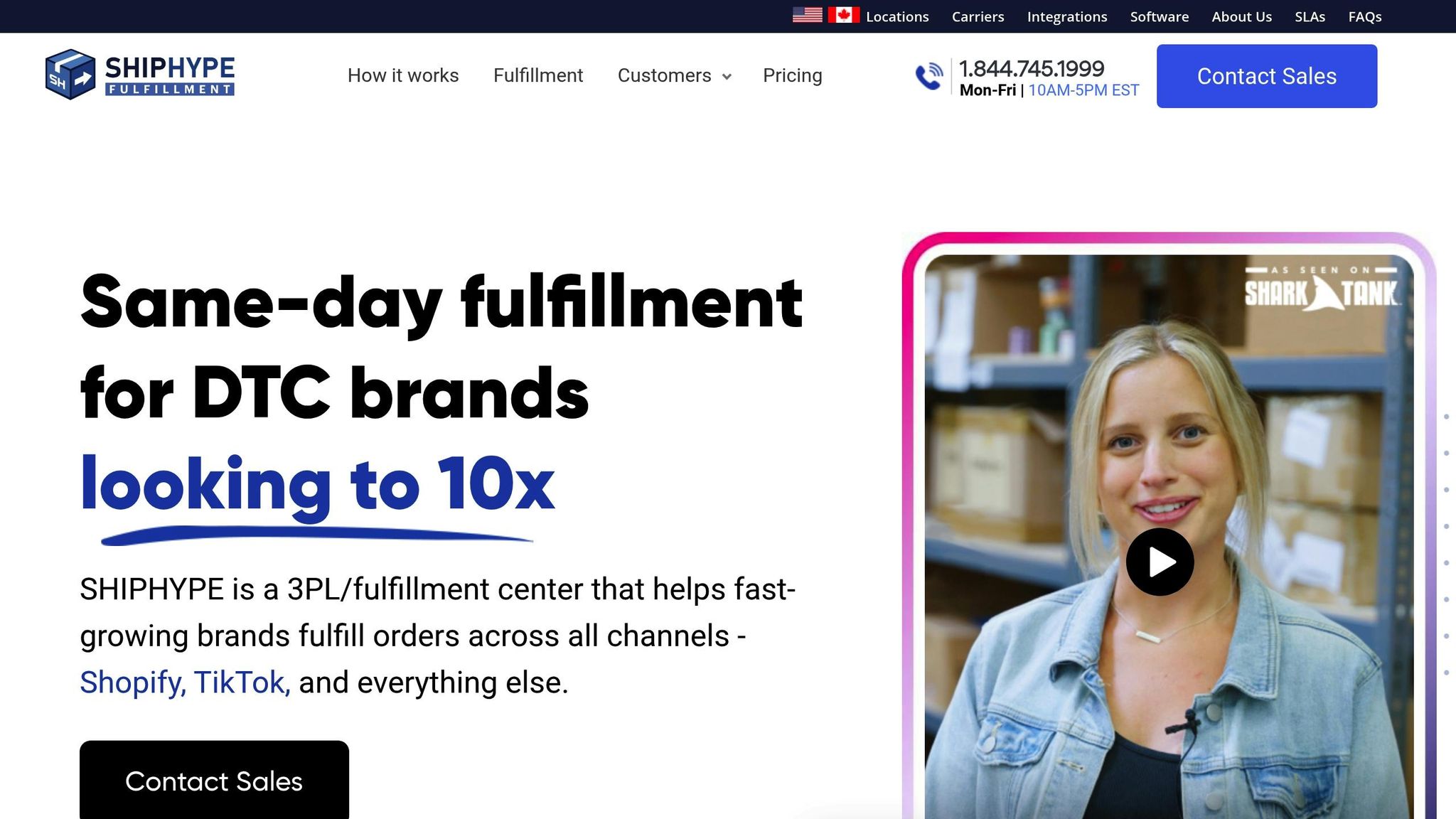Ultimate Guide to Inventory Inspections in 3PL

Inventory inspections in third-party logistics (3PL) are essential for maintaining accuracy, quality, and efficiency in e-commerce operations. These checks ensure products are correctly received, stored, and shipped, preventing costly errors like stock discrepancies, damaged goods, or shipping mistakes. Here's what you need to know:
- Receiving Inspections: Verify quantities, check for damage, and confirm product details upon arrival.
- Ongoing Quality Checks: Use cycle counts, spot checks, and technology (like barcode or RFID scanning) to ensure inventory accuracy and product quality during storage.
- Technology Integration: Tools like warehouse management systems (WMS) provide real-time inventory visibility and detailed audit trails.
- Cost Benefits: Inspections reduce returns, prevent stockouts, and minimize losses from defective or damaged goods.
- Tailored Processes: Inspections are customized based on product type (e.g., electronics require functional testing, apparel needs quality checks).
Do 3PLs Inspect Inventory Upon Arrival? | SHIPHYPE

Core Processes of Inventory Inspections in 3PL Warehouses
Inventory inspections in 3PL warehouses are a meticulous, multi-step process that begins with receiving and continues through storage. These checks ensure accuracy, maintain quality, and safeguard both the 3PL provider and their e-commerce clients. Each stage builds on the previous one, forming a robust system essential for efficient inventory management in e-commerce operations.
Receiving and Verification
The inspection process kicks off at the receiving dock. Here, staff carefully compare incoming shipments with advance shipping notices and purchase orders to identify any mismatches in quantities, incorrect SKUs, or missing items. If discrepancies arise, they’re flagged immediately through exception reports, ensuring issues are resolved before the inventory is logged into the warehouse management system.
Inspectors also verify shipment details such as pallet counts, case numbers, and individual units against shipping documentation. They confirm that serial numbers, lot codes, and expiration dates align with the order specifications.
Special attention is given to temperature-sensitive products like food, cosmetics, or pharmaceuticals. These items undergo temperature logging to confirm they stayed within acceptable ranges during transit. This data is recorded for compliance and quality assurance purposes.
Additionally, the receiving team conducts visual inspections for damage. Crushed boxes, torn packaging, or signs of moisture exposure are noted to catch potential problems early - preventing costly fixes once items move deeper into the warehouse.
Physical Inspections
After the initial checks, products undergo detailed physical inspections. Standardized checklists tailored to each product category ensure that packaging is intact, labels are accurate, and safety standards are met. Any defects are documented, often with photos, to support quality control, insurance claims, or supplier discussions.
For high-value items, every single unit is inspected. Lower-risk products might undergo statistical sampling, where a set percentage of units are checked based on supplier performance and established quality guidelines.
Barcode/RFID Scanning and Data Entry
Technology plays a key role in tracking inventory. Each item is assigned a unique identifier through barcode or RFID scanning, linking it to detailed product information, storage location, and inspection history.
Barcode scanning happens at multiple stages. Upon arrival, scanning confirms the product’s identity and updates inventory levels in real time. As items pass through inspections, additional scans log their quality status and assign them to appropriate storage locations.
RFID technology offers even greater efficiency, allowing hands-free tracking of details like temperature history and handling instructions. This is especially useful in high-volume operations where manual scanning could slow things down.
By keeping inventory data updated in real time, clients gain instant visibility into their stock through web portals or API integrations. This eliminates the need to contact the 3PL provider for updates, streamlining communication and operations.
However, the accuracy of this system depends on proper scanning procedures and thorough staff training. Errors like missed scans or incorrect entries can lead to phantom inventory issues, disrupting order fulfillment. Regular audits ensure scanning accuracy and highlight areas for improvement.
Cycle Counts and Spot Checks
To maintain inventory accuracy, warehouses rely on cycle counts and spot checks. Cycle counts follow a scheduled rotation to verify SKUs, while spot checks are unscheduled inspections aimed at catching anomalies before they escalate.
Spot checks often target specific zones, product categories, or items with a history of discrepancies. These random inspections help uncover systemic issues early, preventing widespread problems.
When discrepancies are found during cycle counts or spot checks, the investigation begins immediately. Staff trace product movements, review recent transactions, and even examine security footage if needed to pinpoint the root cause. This process not only resolves the issue but also helps prevent it from recurring.
The frequency and scope of these inspections are often tailored to client needs. For instance, some businesses request daily cycle counts for critical SKUs, while others may prefer weekly or monthly checks depending on their operational priorities.
Modern warehouse management systems further enhance this process with perpetual inventory tracking. This system triggers automatic cycle counts under specific conditions, such as zero inventory levels or unusually high transaction volumes. By addressing potential issues in real time, these automated checks add another layer of reliability to the inspection framework.
Key Benefits of Inventory Inspections for E-Commerce Businesses
Inventory inspections are a game-changer for e-commerce operations, fine-tuning warehouse management to enhance accuracy, maintain product quality, and increase profitability. By sticking to structured inspection routines, businesses can see firsthand how precise inventory controls elevate 3PL operations.
Improved Inventory Accuracy
Inventory inspections take the guesswork out of managing stock. When warehouse teams regularly check stock levels, the accuracy of inventory records gets a major boost.
This level of precision has a direct impact on order reliability. It minimizes "phantom inventory" - when items appear available in the system but are nowhere to be found in the warehouse. Fewer backorders mean happier customers and smoother operations.
Accurate records also help businesses strike the right balance between supply and demand. Overstocking slow-moving products becomes less likely, while fast-selling items stay in stock, reducing carrying costs and opening up more revenue opportunities. Tools like barcodes and RFID technology provide real-time updates, ensuring full visibility of stock levels. Plus, accurate inventories are the backbone of effective quality control.
Enhanced Product Quality Control
Inventory inspections are critical for catching quality issues before they reach the customer. By physically examining products, warehouses can spot problems like damaged packaging, expired items, or manufacturing defects early on.
This process is especially important for temperature-sensitive goods like cosmetics, supplements, or food. Inspections can identify temperature deviations, allowing businesses to quarantine compromised items before they cause customer complaints.
Inspections also ensure that products match their online descriptions. Catching mismatches in color, size, or included accessories during the receiving process reduces the risk of negative reviews and strengthens customer trust.
Documenting quality issues creates a feedback loop with suppliers. By tracking patterns of damage or defects, businesses can work with vendors to address recurring problems, improving the entire supply chain. Strong quality control not only keeps customers happy but also speeds up order processing by reducing the need for returns or replacements.
Faster Order Fulfillment
Accurate inventory data from inspections streamlines the entire fulfillment process. When warehouse staff can quickly locate products, delays shrink, and orders are processed faster.
Receiving inspections also play a crucial role in assigning products to the right storage spots immediately. By placing items in areas optimized for their size, handling needs, or sales velocity, warehouses can cut down on picking times and increase daily throughput.
Inspections also help flag issues early. Identifying damaged goods before they enter the picking process prevents delays and minimizes the need for customer service follow-ups later on.
Inspection data can even guide inventory placement strategies. Fast-moving items can be stored in easily accessible zones, while slower-moving products can be shifted to secondary storage. This thoughtful organization boosts efficiency and reduces fulfillment costs.
Cost Savings Through Loss Prevention
Inventory inspections also double as a strong loss prevention strategy. By documenting shipping damage during the receiving process, businesses can file claims with carriers instead of absorbing the losses themselves.
Regular cycle counts and spot checks help catch discrepancies early, giving warehouse managers the chance to address issues before they spiral out of control. This proactive approach significantly reduces inventory shrinkage compared to relying solely on occasional full-scale counts.
Inspections also help optimize storage. Verifying product dimensions and handling requirements during receiving ensures items are stored efficiently, reducing wasted space and potentially avoiding the need for costly warehouse expansions.
Detailed inspection records, including photos, strengthen damage claims and minimize financial losses. Altogether, these practices can lead to substantial cost savings that easily justify the investment in inspection staff and technology.
Best Practices for Inventory Inspections in 3PL
To get the most out of inventory inspections, you need a thoughtful approach that blends the right technology, efficient processes, and strong partnerships. These strategies help maintain accurate stock levels while keeping operations running smoothly.
Use Cloud-Based WMS Solutions
Cloud-based warehouse management systems (WMS) make inventory inspections more efficient by offering real-time updates on stock levels, locations, and movements. These platforms track every item as it moves through the warehouse, enabling staff to verify locations, review movement histories, and spot discrepancies - all without sifting through piles of paper records. Plus, their flexibility allows for quick, accurate inspections, setting the stage for effective cycle counting. With these tools, routine inspections become a seamless part of operations.
Schedule Regular Inspections
Technology alone isn’t enough; consistency is key. Implementing a disciplined inspection schedule, like a cycle counting program, is a cornerstone of good inventory management. Instead of shutting down operations for a full warehouse count, cycle counting breaks the task into manageable chunks - daily, weekly, or monthly. This method catches errors early and minimizes disruptions. For example, high-value or fast-moving products should be checked more frequently. Quarterly reviews of inspection metrics with your 3PL provider can further refine processes, identify recurring issues, and improve inventory health. Routine inspections also encourage accountability among staff, leading to better inventory handling and record-keeping.
Train Staff on Inspection Protocols
Your team plays a crucial role in ensuring accurate inventory inspections. Training should focus on both the technical skills - like using barcode scanners, RFID readers, and WMS interfaces - and the ability to identify potential problems. Employees need to know how to spot damage, confirm product details, and escalate unusual findings when necessary. Hands-on training with real-world scenarios builds confidence, while periodic refreshers keep everyone up to date with the latest tools and methods.
Use Advanced Analytics
Data can transform inspection results into meaningful improvements. Advanced analytics tools help uncover trends you might otherwise miss, such as recurring errors in specific warehouse areas or damage linked to certain suppliers. By tracking metrics like cycle count accuracy, shrinkage rates, and how quickly discrepancies are resolved, you can measure the success of your inspection program. Predictive analytics take this a step further, flagging potential issues before they arise and allowing you to adjust inspection schedules proactively. These insights also guide broader decisions, like reallocating resources or investigating persistent problem areas.
Work with Your 3PL Provider
Strong collaboration with your 3PL provider can take your inspection processes to the next level. Clear communication about your inventory accuracy goals ensures their strategies align with your needs. Regular check-ins - such as monthly reviews of inspection results - offer opportunities to tweak processes and address challenges early. For instance, JIT Transportation’s approach to 3PL partnerships focuses on creating custom solutions tailored to each client’s inspection requirements. By combining the provider’s expertise in warehouse management with your product knowledge, you can achieve continuous improvements and develop smarter inventory inspection strategies that support your overall business goals.
sbb-itb-eafa320
Value-Added Services and Inventory Upgrades in 3PL
Today’s 3PL providers go well beyond basic warehousing. They offer specialized services that not only improve inventory inspections but also make operations smoother and more efficient. These added services play a major role in maintaining quality control while simplifying the fulfillment process.
When integrated with inventory inspections, these services create a streamlined system where products aren’t just counted and tracked - they’re also tested, prepared, and optimized for delivery. This is especially helpful for fast-growing e-commerce businesses that need to scale up quickly without sacrificing quality. Let’s break down how testing, assembly, and returns management fit into and enhance inspection protocols.
Testing and Quality Control
Product testing transforms standard inventory inspections into thorough quality evaluations. By embedding testing into their processes, 3PL providers can catch defective items early, saving businesses from the headache of returns and bad reviews.
Testing typically includes functionality checks, durability testing, and compliance verification - all performed during the inspection phase. This combined approach ensures both inventory accuracy and product quality are addressed in one go.
Take JIT Transportation's services, for example. Their facilities integrate product testing into regular inventory cycles, ensuring items meet quality standards before they’re allocated for orders. This not only reduces the risk of shipping defective products but also keeps inventory counts accurate by flagging items that shouldn’t be sold.
For businesses in industries like electronics or cosmetics - where quality is critical - testing services are a game-changer. They allow companies to identify quantity discrepancies and quality issues at the same time, giving a complete view of inventory health.
Kitting and Assembly
Beyond ensuring product quality, 3PLs also offer services like kitting and assembly to create bundled products while maintaining inventory accuracy. These processes transform individual components into ready-to-ship, quality-checked SKUs.
Kitting operations involve several inspection steps: verifying components before assembly, checking quality during the process, and performing a final inspection on completed kits. This ensures accurate inventory records for both the individual parts and the finished products.
For example, JIT Transportation’s kitting services track components throughout the assembly process. This ensures the correct items and quantities are used, and inventory levels remain accurate as individual parts are turned into bundled products. After assembly, final inspections confirm that the kits meet quality standards and include all necessary components.
For e-commerce businesses offering gift sets, product bundles, or promotional packages, these services eliminate the hassle of managing complex assembly operations. At the same time, they maintain strict inventory control, helping businesses create high-value products without logistical headaches.
Returns Management
Just as inspections ensure product quality, effective returns management safeguards inventory accuracy. Processing returns efficiently requires thorough inspections, condition assessments, and precise documentation to keep stock levels accurate.
The returns process starts with evaluating the condition of returned items. Staff assess whether products can be resold, need refurbishment, or should be discarded. This step requires trained personnel who can identify damage, verify completeness, and make appropriate decisions.
Items that pass inspection are reintegrated into inventory systems with updated condition and location details. Products needing refurbishment or disposal are tracked separately to avoid accidental shipment. This requires advanced inventory systems capable of handling multiple item statuses.
JIT Transportation’s returns management services provide a clear example of this approach. Their protocols include inspecting returned items, updating inventory records, and managing the disposition of unsellable stock. This ensures businesses maintain accurate inventory levels while recovering value from returns.
When returns management is integrated with inventory inspections, it creates a closed-loop system. Returned items are processed efficiently, and inventory accuracy is maintained throughout the returns cycle. This is particularly useful for e-commerce companies with high return rates or complex products that require careful evaluation before being restocked.
Just-in-Time (JIT) Inventory Inspections
Just-in-Time (JIT) inventory inspections focus on reducing storage costs while ensuring the quality standards that e-commerce businesses rely on. Instead of stockpiling goods, this method emphasizes precise timing and streamlined processes to keep operations efficient.
By prioritizing speed, JIT inspections require third-party logistics (3PL) providers to carry out quality checks and verifications in tight timeframes - often processing shipments in just hours instead of days.
How JIT Inspections Work
JIT inspections combine thorough quality checks with rapid processing, cutting down on storage time without compromising accuracy. This method aligns inspections with incoming shipments and outgoing orders. Once items pass inspection, they are either assigned to pending orders or moved into high-turnover storage areas.
This approach frees up cash flow by reducing the time inventory sits idle. However, it demands precise coordination. Inspection teams must be ready to process shipments as soon as they arrive, maintaining strict quality standards despite the accelerated pace. This often means having skilled staff available during peak receiving times and using equipment designed for high-speed processing.
JIT inspections are particularly effective for businesses with predictable demand or seasonal products. For example, fashion retailers can quickly inspect and process new collections, ensuring items reach customers while trends are still in demand.
With this streamlined method, 3PL providers play a crucial role in further improving inspection speed and accuracy.
The Role of 3PL Providers in JIT Inspections
The success of JIT inspections hinges on the infrastructure and efficiency of the logistics partner. A 3PL provider must be equipped to handle rapid inspection cycles without sacrificing quality.
Advanced warehouse management systems (WMS) are essential for coordinating shipments, scheduling inspections, and tracking inventory in real time. For instance, JIT Transportation integrates systems that trigger inspection protocols as soon as shipments arrive. Staff are immediately notified of incoming products, specific inspection requirements, and client-defined quality standards, ensuring smooth transitions from receiving to inspection to shipping.
Warehouse design also matters. Facilities optimized for JIT inspections place inspection stations close to receiving docks, minimizing unnecessary movement and reducing handling time. Cross-docking capabilities further streamline operations by allowing products to go directly from incoming trucks to outgoing shipments after inspection, bypassing traditional storage steps.
Flexible staffing is another critical factor. JIT inspections often require varying workforce levels based on shipment schedules and order volumes. Maintaining a trained team that can scale up during busy periods ensures consistent service, even under pressure.
Effective communication systems are equally important. When inspection teams identify issues - such as quality defects or inventory discrepancies - having immediate access to client contacts and predefined protocols helps resolve problems quickly, avoiding delays that could disrupt the entire JIT workflow.
Key Factors for JIT Success
Beyond 3PL support, successful JIT inspections depend on detailed planning and seamless coordination across the supply chain.
One of the most important elements is supplier reliability. Vendors must provide accurate shipping notices, maintain consistent product quality, and adhere to delivery schedules. Any disruption in these areas can ripple through the JIT system, causing delays and quality issues.
Real-time connectivity is essential. Integrating systems like ERP, WMS, and transportation platforms ensures visibility into inventory and inspection processes, keeping operations efficient and synchronized.
Clearly defined quality standards are another cornerstone of JIT success. Inspection criteria should be specific, measurable, and well-documented, covering acceptable quality levels, rejection thresholds, and escalation procedures for borderline cases.
Accurate demand forecasting is also critical. Reliable predictions of order volumes and product types ensure that the right inventory arrives at the right time, avoiding both stockouts and overstocking that could derail the JIT process.
Risk management is vital when inventory buffers are minimal. Contingency plans for supplier delays, quality issues, or unexpected demand spikes can help mitigate disruptions.
Finally, performance metrics must align with JIT priorities. Metrics like inspection cycle time, order fulfillment speed, and inventory turnover are more relevant than traditional measures like storage utilization. Regularly tracking these indicators helps identify and address potential issues before they escalate.
Adopting JIT inspections often requires a shift in mindset across the organization. Teams must prioritize flow and speed over maintaining large stockpiles. Training programs and change management initiatives can help ensure everyone is aligned with this approach, paving the way for smoother operations.
Conclusion
Inventory inspections are the backbone of effective 3PL operations, driving better order accuracy and higher customer satisfaction. When done right, these inspections can turn supply chains into powerful assets rather than just cost centers.
By implementing streamlined inspection processes, businesses can see clear improvements in accuracy, quality control, order fulfillment, and cost savings. Adding advanced practices to the mix can take efficiency and quality to the next level.
One such advanced practice is Just-in-Time (JIT) inspections, which align quality checks with fast-moving operations. This method demands seamless coordination across the supply chain, involving everyone from suppliers to 3PL providers to end customers.
To make these strategies work, businesses need strong operational support, and that’s where an experienced 3PL provider comes in. A trusted partner like JIT Transportation combines cutting-edge technology with scalable infrastructure to optimize every step of the inspection process. Their custom solutions cover everything from transportation and distribution to specialized services like pick and pack, kitting and assembly, and testing. With a nationwide network and advanced tools, they ensure consistent and reliable inspections, no matter the size or growth stage of your business.
Effective inventory inspections don’t just reduce returns - they also enhance customer satisfaction and streamline overall operations. In the fast-evolving world of e-commerce, companies that focus on inventory accuracy and quality control will stay ahead in an increasingly competitive market.
Refining your inspection strategy is key to maintaining efficiency and keeping your customers happy.
FAQs
How do inventory inspections in 3PL warehouses help e-commerce businesses save money?
Inventory inspections in 3PL warehouses play a key role in helping e-commerce businesses cut costs by ensuring precise inventory management. By keeping track of stock levels, businesses can avoid expensive issues like overstocking, running out of stock, or shipping mistakes. Spotting discrepancies early means fewer unnecessary expenses and smoother operations.
Frequent inspections also uncover damaged or expired items, helping businesses minimize losses and boost inventory turnover. Higher turnover reduces storage costs and frees up valuable space, which translates to direct savings. These steps not only simplify your supply chain but also make it more dependable and efficient.
How do barcode and RFID scanning technologies improve the accuracy of inventory inspections in 3PL operations?
Barcode and RFID scanning technologies are game changers when it comes to making inventory inspections more accurate. By cutting down on human errors and simplifying data collection, these tools ensure smoother operations. Barcode scanning focuses on precise item identification, while RFID technology takes things a step further with bulk scanning and real-time updates, boasting accuracy rates as high as 95–99%.
Beyond accuracy, these technologies also boost efficiency. They automate tasks, reduce the need for manual labor, and offer instant insights into stock levels. The result? Faster inspections and better inventory management, which ultimately keeps 3PL operations running like a well-oiled machine.
How can businesses adapt their inventory inspection processes to suit different product types and maintain quality standards?
To maintain high-quality standards across different product types, businesses can tailor their inventory inspection processes by setting up guidelines specific to each product. For example, delicate or high-value items might benefit from advanced technologies such as barcode scanning, RFID, or real-time tracking to ensure precise monitoring and handling.
Implementing zone-based management is another effective strategy. By grouping products into categories, businesses can conduct focused inspections tailored to the unique requirements of each group. This targeted approach ensures that every product type gets the appropriate attention, boosting accuracy and upholding quality standards within 3PL operations.
Related posts
Related Articles

How 3PLs Use Analytics to Lower Shipping Costs

Machine Learning in Logistics: Route Optimization Explained

